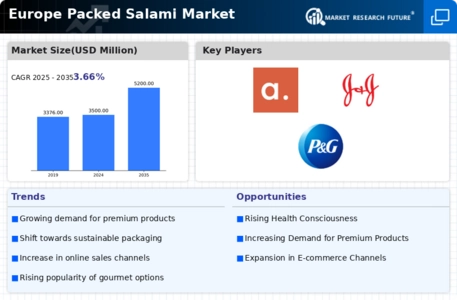Market Growth Projections
The Global Europe Packed Salami Market Industry is projected to experience steady growth over the next decade. With an expected market value of 3500 USD Million in 2024, the industry is anticipated to grow at a compound annual growth rate of 3.66% from 2025 to 2035, reaching an estimated 5200 USD Million by 2035. This growth trajectory suggests a robust demand for packed salami, driven by various factors such as changing consumer preferences, health consciousness, and the expansion of distribution channels. The market's resilience and adaptability to evolving trends may further solidify its position in the global food industry.
Culinary Trends and Globalization
Culinary trends and globalization are playing a pivotal role in shaping the Global Europe Packed Salami Market Industry. As consumers become more adventurous in their food choices, there is a growing interest in international flavors and cuisines. Salami, with its diverse varieties and regional specialties, is well-positioned to capitalize on this trend. The increasing popularity of charcuterie boards and gourmet food experiences is further driving the demand for packed salami. This cultural exchange is likely to foster innovation in product offerings, leading to an enriched market landscape. The industry's adaptability to these trends may result in sustained growth over the coming years.
Rising Demand for Processed Meats
The Global Europe Packed Salami Market Industry is experiencing a notable increase in demand for processed meats, driven by changing consumer preferences towards convenient and ready-to-eat food options. As urbanization continues to rise, consumers are seeking products that fit their fast-paced lifestyles. Salami, being a versatile and flavorful option, is gaining popularity among various demographics. In 2024, the market is projected to reach 3500 USD Million, indicating a robust growth trajectory. This trend is likely to continue as more consumers opt for packaged salami as a convenient snack or meal component, further propelling the industry forward.
Expansion of Distribution Channels
The Global Europe Packed Salami Market Industry is benefiting from the expansion of distribution channels, which enhances product accessibility for consumers. Retailers are increasingly adopting multi-channel strategies, including online platforms, to reach a broader audience. The rise of e-commerce has made it easier for consumers to purchase packed salami from the comfort of their homes. This trend is likely to contribute to the market's growth, as it allows manufacturers to tap into new customer segments. With the ongoing development of logistics and supply chain networks, the industry is poised for further expansion, potentially increasing market share and revenue.
Sustainability and Ethical Sourcing
Sustainability and ethical sourcing are becoming increasingly important in the Global Europe Packed Salami Market Industry. Consumers are now more inclined to support brands that prioritize environmentally friendly practices and humane treatment of animals. This shift is prompting manufacturers to adopt sustainable sourcing methods and transparent supply chains. As a result, products that emphasize ethical production are likely to gain traction among consumers. This trend may also influence pricing strategies, as premium products with sustainable credentials could command higher prices. The industry's responsiveness to these consumer demands may enhance its reputation and foster long-term loyalty.
Health Consciousness and Quality Ingredients
In recent years, there has been a growing awareness among consumers regarding health and nutrition, which is influencing their purchasing decisions in the Global Europe Packed Salami Market Industry. Consumers are increasingly seeking products made from high-quality, natural ingredients without artificial additives. This shift towards healthier options is prompting manufacturers to innovate and offer salami products that cater to health-conscious consumers. As a result, the market is expected to grow steadily, with projections indicating a rise to 5200 USD Million by 2035. This focus on quality and health may also lead to the introduction of premium salami varieties, appealing to discerning consumers.














Leave a Comment